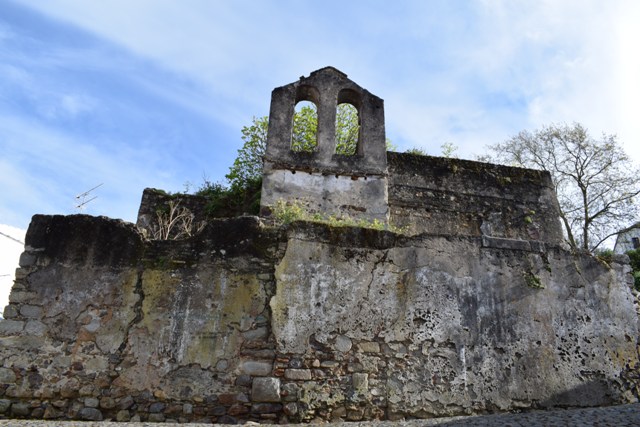


Home > Those raised from this ground
The original town of Montemor-o-Novo was based on the castle. The first written references to the settlement date from 1181. However, it was only in 1201 that the town was finally conquered by the Portuguese King Sancho I, who granted the town its first charter in 1203. This was renewed by King Manuel I in 1503. The importance of the town was again recognised by King Sebastião in 1563 when he granted it the title of Vila Notável – Notable Town.
Montemor-o-Novo played an important role in combating the invasion by Castille in 1580 and this will to resist was again in evidence during the first French invasion, commanded by Junot, in 1808. During the civil war (1832-1834), the city hosted the general staff of the liberal army, commanded by the Duke of Saldanha. In the 20th century, the people of Montemor adopted a posture of resistance and revolt against Salazar’s dictatorial regime, which is recalled in José Saramago’s Raised from the Ground. In 1988, the status of city was conferred on Montemor-o-Novo by the Assembly of the Republic.
The Germano Vidigal and José Adelino dos Santos Walking Tour visits the most important places associated with the tragic stories of the murders of Germano Vidigal and José Adelino dos Santos, the only two characters in Raised from the Ground whose original names are used, and to whom José Saramago dedicated all the different editions of the book.In the municipality of Montemor-o-Novo, during the 48-year period of the fascist dictatorship, hundreds of workers were arrested, tortured and persecuted, mostly PCP militants, but also other democrats. Two PCP activists were murdered: Germano Vidigal on 20th May 1945 and José Adelino dos Santos on 23rd June 1958.
Type of tour:
Walking tour
Tour name:
Germano Vidigal and José Adelino dos Santos
Location:
38°38’38”N 8°12’38”W Rua do Matadouro: start of tour
Parish:
Union of Parishes of Nossa Senhora da Vila, Nossa Senhora do Bispo and Silveiras
County (distrito):
Montemor-o-Novo
Route:
Rua do Matadouro – Largo Prof.Dr. Banha de Andrade – Rua D. Sancho I – Rua Dom Vasco – Rua da Condessa de Valença – Rua do Quebra Costas – Rua Germano Santos Vidigal – Largo Joaquim Pedro Matos – Terreiro de São João de Deus – Rua Teófilo de Braga – Largo dos Paços do Concelho – Largo Alexandre Herculano – Rua do Passo – Rua 5 de Outubro – Rua de Aviz – Avenida Gago Coutinho – Rua de São Francisco
For Thematic Tour 2: Montemor-o-Novo – EN114 – Évora
Type:
Walking tour
Distance:
2.5 km
Average duration:
3 hours
Type of surface:
Urban roads
Signage:
Yes
Landowners:
Public right of way
Sights to see:
Useful contacts:
City Council 266 898 100
Tourist Information Centre 266 898 103
Municipal Archive 266 898 100
Emergency:
GNR National Guard Police 266 898 050
Fire brigade 266 899 180
Health Centre: 266 898 900

Home > Those raised from this ground
Next to Rua do Matadouro, in the former Rossio square, is the Bullring.
It was in this arena that about 1,500 rural workers took part in a demonstration on 20th May 1945. Among them was Germano dos Santos Vidigal (1910-1945), president of the Civil Construction Union and leader of the local Communist Party, whose murder, following seventeen days’ torture, demonstrated the extreme brutality of fascist repression.
The men talk to pass the time or to prevent it from passing, it’s a way of putting your hand on your heart and saying, Don’t go forward, don’t move, if you take another step, you’ll crush me, what did I ever do to It’s also like bending down, placing one hand on the earth and saying, Stop turning, I want to see the sun for a while longer. While all this is going on, this heaping of words one upon another, just to see if they come out differently, no one has noticed that the constable has entered the ring in search of a man, just one, who is not even a lion with a sickle and who has not even come very far, and that man, if he were given an exercise book in which to write down all he knows, as the four from Monte Lavre, Escoural, Safira and Torre da Gadanha will do the following day, that man would write on the first line or on every line, so that there could be no doubt and so that there could be no change of heart from one page to the next, as I say, if he were to write his name, he would write Germano Santos Vidigal.
They have found him. Two guards lead him away, and whichever way we turn, that is all we see, they lead him out of the ring, to the exit door from sector six where two more guards join them, and now it seems deliberate, it’s uphill all the way, as If we were watching a film about the life of Christ, up there is the calvary, and these are the centurions in their stiff boots and warrior-like sweat, their spears cocked, it’s suffocatingly hot. Halt.
(Raised from the Ground, Saramago, 2018, pp.169-170)
The murder of Germano Vidigal in 1945 occurred in the aftermath of the great social unrest experienced at the time of the Second World War, caused by the severe economic crisis that devastated the country. The Portuguese people and workers were deprived of the most basic goods, such as bread and bacon, which were exported in huge quantities by Salazar’s government to feed the Nazi troops. The terrible crisis led to an increasing climate of popular revolt which had taken on the form of revolutionary political struggle since the 1940s. The reorganisation of the Portuguese Communist Party in 1940-41 contributed greatly to this, exerting a great influence on the working class by raising political awareness and demands made in the clandestine press, such as O Camponês and Avante – which began to be published regularly from then on – as well as other less important publications. The clandestine station Radio Moscow, which began broadcasting in Portuguese in 1930, and especially the clandestine meetings that encouraged the masses to organise and mobilise in support of the struggle also contributed much.
The victory of the Allies over the fascist Nazi regime brought some hope and joy to the people, who turned out in their thousands in towns and villages all over the country and marched against hunger. In Montemor-o-Novo, we remember, for example, a demonstration by 700 country people who demanded better wages, bread and bacon, held outside the Casa do Povo in April 1945. A month later, on 20th May, more than 2,000 workers presented a list of demands, outside the Casa do Povo and the Grémio da Lavoura. The regime’s repression of the workers’ growing resistance in the municipality was not long in coming. The following day, around 1,500 men and women were held in Montemor-o-Novo Bullring. (cf. Fonseca, 1987, p. 93).
In a brochure entitled A História do Nascimento do PCP em Montemor-o-Novo – The History of the Establishment of the PCP in Montemor-o-Novo, António Gervásio, a native of Montemor who joined the PCP in 1945, recalls a plenary session of party workers held in May, during which more than 30 workers met at night in an open field outside the Church of Our Lady of the Visitation. This mobilised more than 1,000 people, who demonstrated outside the GNR national guard station, demanding bread and work. The station commander, Lieutenant Pessoa, suggested that the protesters move into the bullring in order to discuss the issue and, according to Gervásio, the people acquiesced. Once inside, they were locked in and couldn’t get out. The commander had played a trick on them. (cf. Gervásio, 2013).

Construída no século XIV, foi a primeira igreja fora da vila muralhada.

+351 266 890 040

Home > Those raised from this ground
Continue along Rua do Matadouro then turn right into Rua D. Sancho I. Go around Largo Dr. Banha de Andrade square and you will see the Montemor-o-Novo Ethnology Centre – Local Museum.
Digressing from the path followed by Germano Vidigal, recounting the tragic events of his murder, a visit to the Ethnology Centre will enable you to travel back in time to the era in which the book is set, with a display of the material and immaterial cultural heritage of the Alentejo people in the 20th century, featuring rural tools of work associated with some jobs that are no longer found or are on the verge of disappearing. Items were collected by the following local cultural groups: Rancho Folclórico e Etnográfico Montemorense, Rancho Folclórico do Ciborro, Rancho Folclórico de Cortiçadas de Lavre and Rancho Folclórico de Foros de Vale Figueira.
Man has many jobs to do. We’ve mentioned some already and now we add others for the purpose of general enlightenment, because townspeople think, in their ignorance, that it’s all a matter of sowing and harvesting, well they’re much mistaken unless they learn all the other verbs involved and realise just what they mean, harvesting, carrying sheaves, scything, threshing either by machine or by hand, flailing the barley, covering the hayrick, baling up straw or hay, shucking the maize, spreading manure, sowing seeds, clearing land, cutting up the maize stalks and forking them in, shoeing, pruning, ringing, levelling, digging ditches and trenches, hoeing, making terraces, grafting vines, taping up the graft, spraying with copper sulphate, carrying the grapes, working in the cellars, labouring in the vegetable plots, preparing the ground, bating the olive trees, working the oil presses, cutting cork, shearing sheep, cleaning wells, hacking undergrowth, chopping firewood, taking, covering with straw, earthing up, plugging, bagging up, and whatever else needs doing, all those lovely words, enriching our lexicon, blessed be the workers, and if we were to start explaining how each task is performed and in which season, and the tools and the implements, and whether it was men’s work or women’s work and why …
(Raised from the Ground, José Saramago, 2018, pp. 88-89)

+351 266 890 040

Home > Those raised from this ground
In Largo Prof. Dr. Banha de Andrade square, facing the castle, cross Rua de São Domingos and go along Rua D. Vasco, and you will find the GNR National Republican Guard Police Station.
On 23rd May Germano Vidigal was taken to the GNR station in Montemor-o-Novo, where he died on 9th June, the victim of a cruel and barbaric murder carried out by two PIDE agents, known for their terror tactics and the barbarity of the interrogations they conducted: Barros and Carrilho (Avante, 2010), to whose characters in the novel José Saramago gave the names “Escarro” and “Escarrilho”. Germano Vidigal did not give away his comrades, remaining firm right up until the last moment of his short life.
… when they returned, found the prisoner had hanged himself on a piece of wire, just as we see him now, with one end tied around that nail there, and the other wound twice around Germano Santos Vidigal’s neck, yes, his name’s Germano Santos Vidigal, it’s important to know that for the death certificate, the official doctor must be called, yes, as you can see, he’s kneeling, yes, kneeling, but there’s nothing odd about that, if someone wants to hang himself, even if it’s only from a bedstead, it’s all a matter of will, does anyone have any questions, Not me, say the lieutenant, the sergeant and the corporal, and the two privates and the three prisoners, who thanks to this stroke of luck will probably be set free today. There is great indignation among the ants, who witnessed everything, at different times, but meanwhile they have joined forces and pieced together what they saw, they know the whole truth, even the larger of the ants, who was the last to see the man’s face close up, like a vast landscape, and it’s a well-known fact that landscapes die because they are killed, not because they commit suicide. The body has been removed. Escarro and Escarrilho put away the tools of their trade, the stick, the cat-o’-nine-tails, they rub their knuckles, inspect the tips and heels of their shoes, in case some thread of clothing or some bloodstain should reveal to the sharp eyes of Sherlock Holmes the weakness of their alibi and the conflicting times, but there’s no danger of that, Sherlock Holmes is dead and buried, as dead as Germano Santos Vidigal buried as deep as Germano soon will be, and the years will pass and these cases will remain swathed in silence until the ants acquire the gift of speech and tell the truth, the whole truth and nothing but the truth.
(Raised from the Ground, Saramago, 2018, pp. 180-181)
The official verdict on Germano Vidigal’s death is suicide by hanging. In the work by José Saramago there is a version that, while it is a fictional narrative, is much truer to oral testimonies.
João Machado, a Montemor worker and a member of the PCP from 1943, was also arrested in the same PIDE raid. From the analysis of documents displayed in the exhibition entitled “A Semente e os Frutos” – Seed and Fruit, it is clear that João Machado was one of the testimonies that José Saramago used to find out about the tragedy of Germano Vidigal. Let us look at an excerpt from the testimony that José Saramago used, on display at the exhibition.
“When Germano Vidigal died, the doctor who was subhead of the health service at that time, Dr. Romão, told me that he had hanged himself. And I said to him: “You know better than anyone that the man was killed in a brutal and criminal way.”, “Yes, João, but we can’t say that.”, “Maybe you can’t, sir, but I can. And you, as a doctor, as subhead of the health service, have a responsibility to tell the truth.”, “But I can’t. And you be careful.”, “You should say that he hanged himself.”, “Oh, I won’t do that, but you be careful: you could still end up in prison again.”” (Machado, 1977).
We spoke to João Machado’s daughter, Margarida Machado, about her memories of meetings between her father and José Saramago and the importance of his literary work for preserving the memory of these events.
“The book was written by José Saramago but it contains their stories, the history of struggle and the resistance of the people of Montemor-o-Novo. This has brought them great joy, which they will keep in their hearts for future generations. [On the Nobel Prize] It provided recognition for the writer, and in a way also for the lives that were lived and for the people of Montemor-o-Novo. They felt it that way too. And his friendship with João Machado deepened when he returned to the city, Saramago was glad to see people he hadn’t seen for a long time. At their meeting both João Machado and he have a very happy expression.” (Machado, 2019).

Construída no século XIV, foi a primeira igreja fora da vila muralhada.

+351 266 890 040

Home > Those raised from this ground
Go up to the castle via Rua D. Vasco and Rua Condessa de Valenças, a steep climb. The entrance to the castle is via Porta da Vila, next to the Clock Tower, and continue walking until you reach the castle walls. From on high, look out towards the City Hall, in Largo dos Paços do Concelho square, where José Adelino dos Santos was murdered by the GNR on 23rd June 1958.
Around 300 workers were at the demonstration, demanding better wages and showing their dissatisfaction with the recent fraudulent elections of 8th June 1958 for the Presidency of the Republic, in which the “fearless general”, Humberto Delgado, was defeated, despite the enormous support that he received from the Portuguese people, especially in the Alentejo.
From up here, you can see them walking down the narrow lanes and converging on the square outside the town hall. They may look like ants, but they’re dogs, now there’s the whole situation summed up in one brief, clear phrase, and then silence falls, we don’t want to miss anything, look, there’s already a squadron of guards in front of the town hall, and there’s the sergeant, what’s that he holding, a machine gun, that’s what Gracinda Mau-Tempo thought too, and glancing up at the castle, she saw that it was full of people, who can they be.
The square fills up. The people from Monte Lavre are standing in a group. Gracinda, the only woman, her husband Manuel Espada, her brother and father, António and João Mau-Tempo, and Sigismundo Canastro, who says, Stick together, and there are two other men called José, one is the great-grandson of the Picanços who kept the mill at Ponte Cava, and the other is José Medronho, whom we haven’t had occasion to mention until now. They are in a sea of people, the sun beats down on this sea and burns like a nettle poultice, while up in the castle, the ladies open their sunshades, anyone would think it was a party. […]
The shouting has begun, We want work, we want work, we want work, that’s about all they say, apart from the occasional insult, you thieves, but spoken so quietly that it’s as if the person hurling the insult were ashamed, then someone else shouts, Free elections, what’s the point of saying that now, but the great clamour of voices rises up and drowns out everything else, We want work, we want work, what kind of a world is it that divides into those who make a profession of idleness and those who want work but can’t get it.
(Raised from the Ground, Saramago, 2018, pp. 326-328)
The castle of Montemor-o-Novo is where the original castle walls enclosed the old town of Montemor-o-Novo. The castle was conquered from the Moors by King Alphonse Henry just after 1166. Some of the castle walls and towers remain, along with ancient religious buildings and the ruins of the Paço dos Alcaides palace. It was here that the first voyage to India by the Portuguese discoverers was discussed.
José dos Santos was born in 1912, and was known by his father’s first name, Adelino. He was a communist militant, arrested twice by the PIDE, in 1945 and 1947, and murdered on 23rd June 1958. The reaction of revolt following his death was felt from north to south, generating a climate of protest at the national level at a crime that, according to Teresa Fonseca, was premeditated (cf. Fonseca, 2008). José dos Santos was greatly admired by the people of Montemor, as the words of his friend and comrade José Salgueiro bear out: “The only one in the Party like him was João Machado. They were both intelligent, but in my view he excelled a little in terms of vision because some people are militants and fanatics but he wasn’t. He was a staunch Party activist, but in his private life he was outstanding, the like of which I have never seen!” (André, 2017, p.39).
On the morning of 23rd June 1958, José dos Santos, António Farrica, António Malhão, and João Machado, among others, travelled to the outskirts of the town to mobilise the working people for a day of protest that afternoon. António Farrica and João Machado were arrested by the GNR, and João Machado was violently beaten. Neither these events, nor the fact that he was also intercepted and threatened by the GNR that morning discouraged José dos Santos from taking part in the mass-meeting of working people.
At this point of interpretative interest, we remember the role of Lavre’s “Gracinda, the only woman” at the demonstration. While “João Mau-Tempo” follows a path from resignedness to supporting the demands made by the workers, and the revolutionary struggle is portrayed through a single character. This path is followed by three generations of women. There is a similar posture of resignedness, with “Sara da Conceição”, who suffers in silence, and also “Faustina Mau-Tempo”, although we see in the latter an attitude of protest that is more vocal, but “Gracinda” is a woman who has an active voice in the social struggle. From cowed silence to revolutionary fervour, we trace the progress of three generations of women. It is “Gracinda” who, as “João Mau-Tempo” says is the ‘daughter raised from the ground’.

Construída no século XIV, foi a primeira igreja fora da vila muralhada.

+351 266 890 040

Home > Those raised from this ground
While contemplating the vast horizon, go down Rua do Quebra Costas and Rua Germano Santos Vidigal and at the end of the street on the right what is now a private residence was for decades the metal workshop where Germano Vidigal worked. Now bear left into Largo Joaquim Pedro Matos square and turn left again into Terreiro de São João de Deus square, named after the patron saint of the city of Montemor-o-Novo. Next to the parish church, in the former Convent of São João de Deus, an 18th-century building renovated by the city council, there are the Municipal Library and the Municipal Art Gallery, as well as the recently opened Raised from the Ground Interpretive Centre.
This space offers the visitor a unique experience. Through the use of a range of technological devices and gaming and teaching strategies you can learn more about the context of José Saramago’s work and related historical and ethnographic aspects of the municipality of Montemor-o-Novo.
Schedule:
Wednesday to friday
Winter: 14h00-17h30
Summer (july and august): 14h00-18h00
Closed on public holidays, in lieu of time off and at other times when decided by the autarchy.
Information and booking
Guided tour for groups – Monday to Saturday.
9 a.m. to 6 p.m. (last visit at 5 p.m.)
Guided tours need to be booked 15 days in advance and are subject to availability.
Contacts:
+351 969 289 483
+351 266 898 107
roteirolevantadodochao@cm-montemornovo.pt

+351 266 890 040

Home > Those raised from this ground
After visiting the Raised from the Ground Interpretive Centre, go down Rua Teófilo Braga to Largo dos Paços do Concelho, where the City Hall is located. At the side there is a monument in honour of José Adelino dos Santos.
On 23rd June 1958, the mayor, José Nunes Vacas, refused to receive some workers who wanted to discuss measures that could reduce the high cost of living, which meant hunger and misery for the working population. Instead of opening a dialogue, Vacas called the PIDE and the GNR, who sent a contingent of guardsmen reinforced by others from Évora and Vendas Novas.
This was the charge of the twenty-third of June, fix that date in your memory, children, although others dates adorn the history of the latifundio, and are deemed glorious for the same or similar reasons. The infantry also excelled itself, especially Sergeant Armamento, a man with blind faith and a wrong-headed view of the law, there’s the first burst of machine-gun fire, and another, both of them fired into the air as a warning, and when the people in the castle hear these shots, they cheer and clap, the sweet girls of the latifundio, faces scarlet with heat and bloodthirsty thoughts, and their mothers and fathers, and the boyfriends trembling with the desire to get out there themselves, lance in hand, and finish the job just started, Kill them all. The third burst of fire is aimed low, all that target shooting is proving its worth, let the smoke clear, not bad, although it could have been better, there are three men lying on the ground, one of whom is getting up, clutching his arm, he was lucky, another is dragging himself painfully along, one leg incapacitated, and that one over there isn’t moving at all, It’s José Adelino dos Santos, it’s José Adelino, says someone from Montemor, who knows him. José Adelino dos Santos is dead, he got a bullet in the brain and couldn’t believe it at first, but shook his head as if he had been bitten by an insect, then he understood, Those bastards have killed me, and he fell helplessly backwards, with no wife there to help him, his own blood formed a cushion under his head, a red cushion, if you please. The people in the castle applaud again, they sense that this time it’s serious, and the cavalry charges, scattering the crowd, someone should pick up the body, but no one approaches.
(Raised from the Ground, Saramago, 2018, pp. 328-329)
The GNR cavalry enters the city hall and violently expels the protesters. Shots fired inside the building can be heard outside in the street. José Adelino dos Santos is shot and dies, murdered by the agents of the regime. The feeling of revolt and discontent in the part of those present can be seen in the gestures of just one man, António Piteira, “with his hands covered in the blood of his friend. In a state of profound agitation, he organised a rally, expressing his revolt against the dictatorship and the tragedy that had just occurred. And in the face of insistent police orders to keep quiet, he responded in a defiant tone that they should kill him too.” (Fonseca, 2008, p. 219).
José Adelino’s funeral was shrouded in great controversy, as narrated by José Saramago. Let us recall an excerpt from the conversation between the characters “Leandro Leandres” and Doctor “Cordo”.
I’m warning you, if you don’t take him, you’ll pay for it, and the doctor answers, Do what you like, but I’m not taking a dead man to Lisbon, and having said that, he left the room to deal with the genuinely wounded, of which there were many, and some of whom went straight from there to prison, in fact, more than a hundred men, whether wounded or unscathed, were arrested, and if José Adelino dos Santos did end up being transported to Lisbon, it was simply a drama put on by the PIDE, a way of pretending that they had done everything they could to save him, a form of mockery really, and along with José Adelino dos Santos, they took others men arrested on that same day, and each one suffered, as João Mau-Tempo suffered and as we have described. (Raised from the Ground, Saramago, 2018, p. 331)
At José Adelino’s funeral, 2,500 people awaited the coffin, and 300 GNR officers, armed with machine guns, surrounded Montemor-o-Novo, creating an atmosphere of great tension. The following month, the following was published in Avante: “The funeral was accompanied from Vendas Novas by a cortege of ten GNR jeeps commanded by Captain Caldeira from Évora. They drove around with the coffin to try and avoid the crowd that was waiting. But the people broke through the line of guardsmen blocking the way to the cemetery and over 1,500 gathered there. The funeral was the occasion of a great manifestation of revulsion against the murderers.” (Avante, 1958).

Construída no século XIV, foi a primeira igreja fora da vila muralhada.

Home > Those raised from this ground
Cross Largo Alexandre Herculano square and go along Rua do Passo, then turn right and go up Rua 5 de Outubro to Rua de Aviz, which leads to Avenida Gago Coutinho. Go forward a few metres and turn left into Carreira de São Francisco and you will come to the cemetery, on your right, where José Adelino dos Santos is buried. Go straight on and you will come to the Municipal Historical Archive, the end of this walking tour.
Based in a former jail, the archive houses and disseminates information about the memory of the municipality as a whole, holding documents dating from the 15th century up to the present.
Part of the archive comprises the CDARA – Centro de Documentação e Arquivo da Reforma Agrária – Agrarian Reform Documentation and Archive Centre. This is an essential source of information for both researchers and readers who seek to find out about the historical context of Raised from the Ground. Here, you can find a range of different documentation on the social, economic and political aspects of the lives of the people that inspired José Saramago. The Agrarian Reform Archive consists of the fund of documentation of the former collective agricultural production units throughout the Alentejo and Ribatejo, agricultural unions, and Agrarian Reform meetings as well as other organisations supporting this movement. All this documentation, brought together by the city council and on loan from its respective owners, is aimed at safeguarding archives which enable forms of organisation, economic activity, social relations and other aspects of the Agrarian Reform period to be studied.
After Mantas, they go to Vale da Canseira, to Relvas, to Monte da Areia, to Fonte Pouca, to Serralha, to Pedra Grande, and at each farm, they take the keys and draw up an inventory, we are workers, not thieves, not that there is anyone there to contradict them, because in each place they occupy, in each house, room, cellar, barn, stable, hayloft, pen, run, corral, pigsty, chicken coop, cistern and irrigation tank, there are no Norbertos or Gilbertos to be seen, whether talking or singing, silent or weeping, who knows where they have gone. The guards stay in their barracks, the angels are busy sweeping heaven, it’s a day of revolution, how many of these workers are there.
(Raised from the Ground, José Saramago, 2018, p. 385)
In addition to the Archive, the Documentation Centre holds a collection of varied materials, including books, photographs, videos, posters, and newspapers, among other items, that document Agrarian Reform. Of special interest is the recent Raised from the Ground Literary Itinerary Archive of Interviews, which enables users to learn about the work from a range of different perspectives, from biography, literary studies, anthropology, and political science to local historiography. This is just some of the documentation that relates to the context of the Raised from the Ground that you can access at this space of culture and history.
Necessary cookies are absolutely essential for the website to function properly. These cookies ensure basic functionalities and security features of the website, anonymously.
Functional cookies help to perform certain functionalities like sharing the content of the website on social media platforms, collect feedbacks, and other third-party features.
Performance cookies are used to understand and analyze the key performance indexes of the website which helps in delivering a better user experience for the visitors.
Analytical cookies are used to understand how visitors interact with the website. These cookies help provide information on metrics the number of visitors, bounce rate, traffic source, etc.
Advertisement cookies are used to provide visitors with relevant ads and marketing campaigns. These cookies track visitors across websites and collect information to provide customized ads.
Other uncategorized cookies are those that are being analyzed and have not been classified into a category as yet.